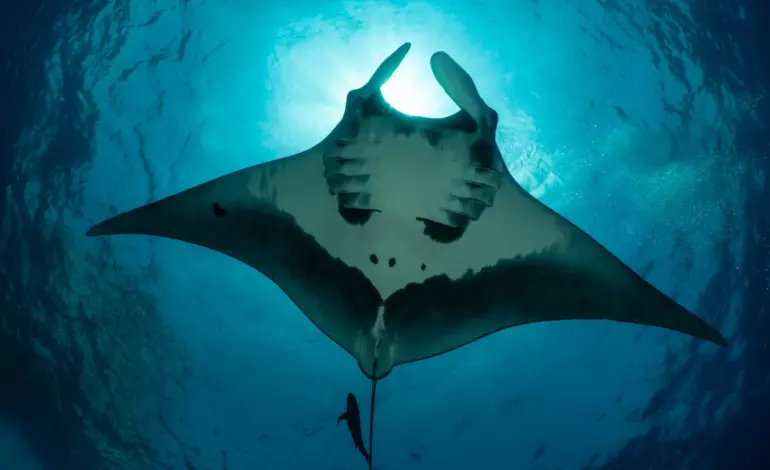Manta Rays Dive Deep to Navigate Ocean’s Mysteries

Recent research has revealed that oceanic manta rays, known scientifically as Mobula birostris, are capable of diving to depths greater than 1,200 meters (approximately three-quarters of a mile). This behavior is not primarily for feeding or evading predators, but rather serves as a method for these rays to calibrate their navigation in the open ocean, akin to using a natural form of Google Maps. The findings stem from a collaborative study conducted by an international team of scientists from Peru, Indonesia, and New Zealand.
The research, led by first author Dr. Calvin Beale from Murdoch University, involved tagging 24 manta rays across three distinct sites: Raja Ampat in eastern Indonesia, near Tumbes off the coast of Peru, and near Whangaroa in New Zealand’s northeastern waters. The study yielded a total of 2,705 tag-days of data, revealing that these majestic creatures frequently performed deep dives, with a remarkable maximum recorded depth of 1,250 meters (0.78 miles).
The focus of these deep dives appears to be linked to navigation. Researchers observed that on 79 days, manta rays dove to extreme depths, with nearly all of these dives occurring off the coast of New Zealand. Notably, each ray initiated its first extreme dive shortly after transitioning from the continental shelf into deeper ocean waters.
Understanding the Purpose of Deep Dives
The diving patterns of the manta rays were characterized by a stepped descent and ascent, suggesting that these dives were not aimed at hunting or escaping threats. Instead, the rays spent minimal time at their maximum depths, indicating a different purpose. Following these dives, the mantas traveled considerable distances, sometimes covering up to 200 kilometers (124 miles) within a few days.
Dr. Beale elaborated on the significance of these findings, stating, “By diving down and ‘sampling’ these signals, they could build a mental map that helps them navigate across vast, featureless stretches of open ocean.” He emphasized that the mantas likely use environmental cues such as changes in magnetic field strength, oxygen concentration, temperature, and light to inform their navigation.
In this study, the mantas off New Zealand were observed to dive deeper as they began their northward migration, suggesting that these dives serve as a means of refining their navigational bearings. Dr. Mark Erdmann, Shark Conservation Director at Re:wild and co-author of the study, highlighted that the rays exhibit specific post-dive behavior, spending time at the surface to recover from thermal stress before moving with purpose towards their migratory destinations.
The Implications for Conservation
The researchers believe that the necessity for deep dives is linked to the stability and predictability of the deeper ocean environment compared to the more variable conditions closer to the surface. The unique underwater topography off New Zealand, where the seabed drops sharply, likely necessitates these navigational recalibrations.
While the study involved a limited sample size, the insights gained provide a foundation for future research on the navigation strategies of oceanic manta rays. “The paper examines these dives in detail and concludes that the likely reason the mantas braved the cold, dark, deep waters was not in search of food, nor to avoid predators—but likely for navigational purposes,” noted Dr. Erdmann.
The research has broader implications for understanding migratory species and their dependence on both coastal and offshore habitats. With oceanic manta rays classified as endangered, the findings underscore the urgent need for international cooperation in their conservation. Dr. Beale concluded, “Our study highlights how dependent migratory species are on both coastal and offshore habitats, stressing the need for international cooperation in their conservation. It also reminds us that the deep ocean— which regulates Earth’s climate and underpins global fisheries—remains poorly understood but vitally important.”
These groundbreaking findings were published in the journal Frontiers in Marine Science, paving the way for further exploration into the behaviors and needs of these remarkable creatures.






